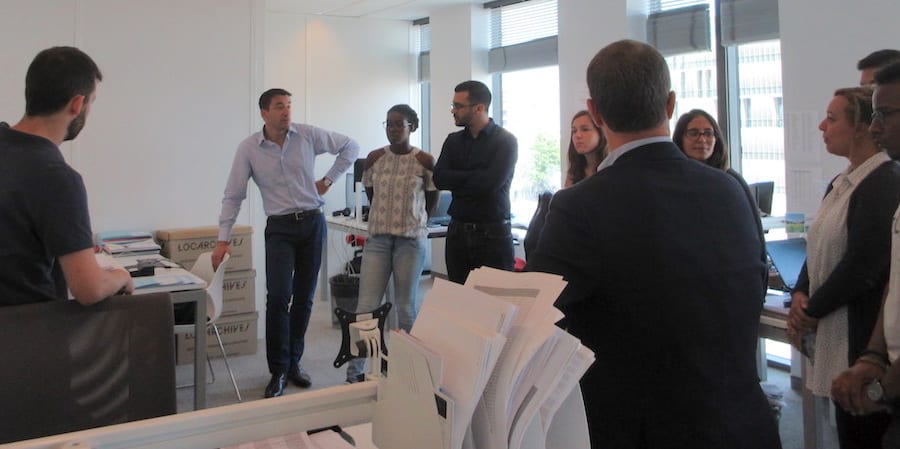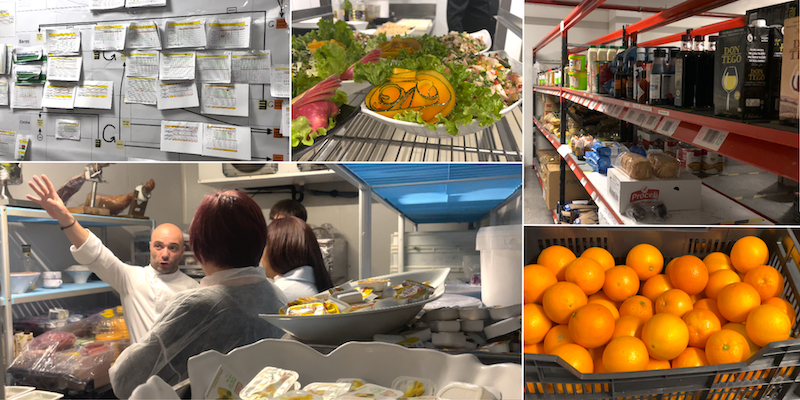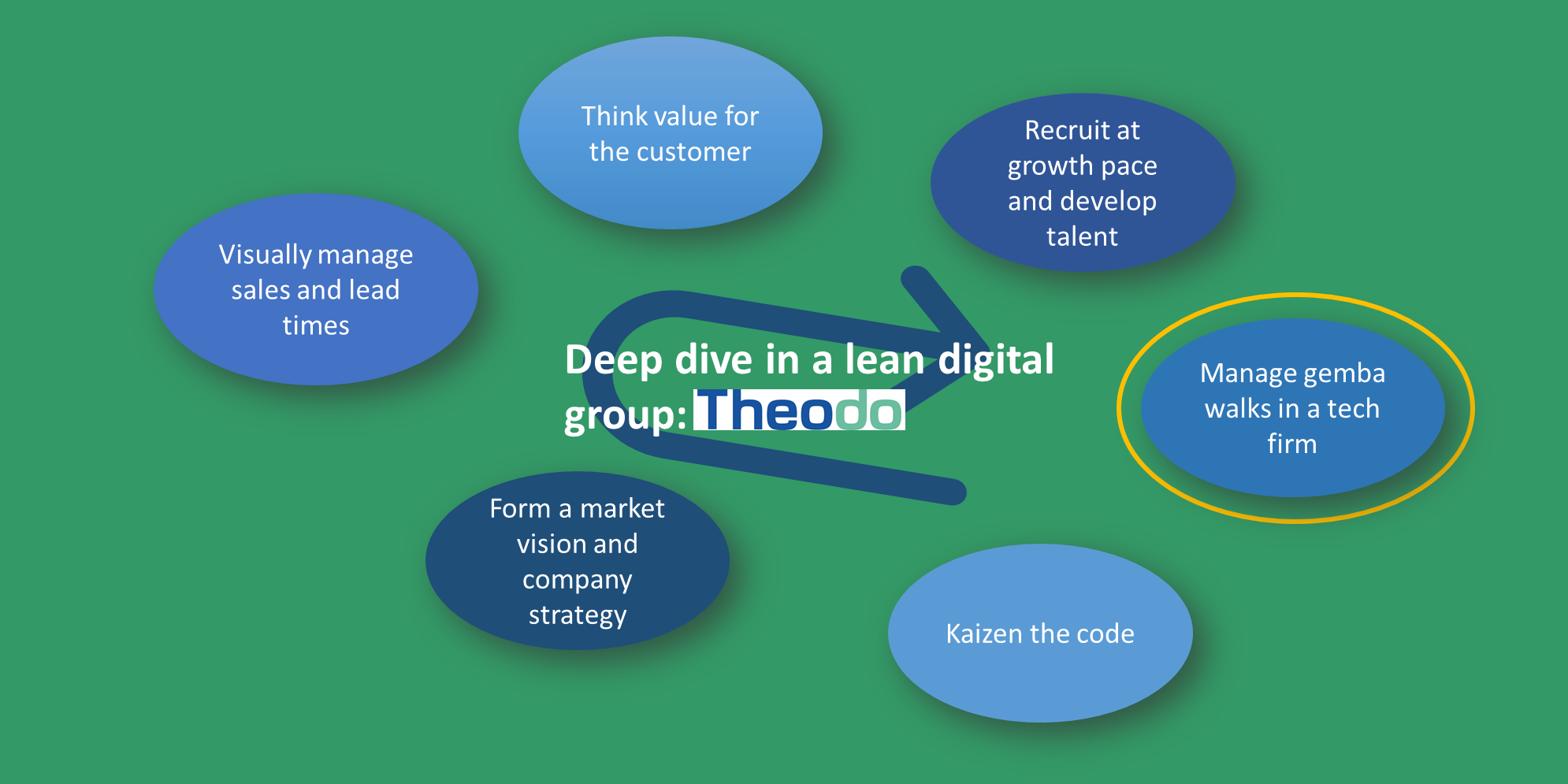
Walking the gemba at French start-up Aramis Auto
NOTES FROM THE GEMBA – Catherine’s gemba walks are back after the summer break. This month, she visits a start-up that is using lean to manage its growth, and learns about its management’s extraordinary turnaround.
Words: Catherine Chabiron, lean coach and member of Institut Lean France
How do you actually manage growth? Launching a start-up is hard enough, but how do you keep it focused and reactive as it grows? This is the topic I wanted to discuss with Nicolas Chartier, one of the two founders of Aramis Auto, as well as its Managing Director, when I visited the company this summer.
Over the past 16 years, Aramis Auto has developed as a rather unique multi-brand car selling business in France. The company was created in 2001, and steadily grew from a team of two (the founders) to a team of 550. It operates out of 30 sites, including a plant dedicated to reconditioning used cars before they are sold. Aramis Auto provides a comprehensive range of services: used cars sales, new cars sales, trade-ins, financing, online or local sales offices (in close proximity to customers), home delivery and pickup, and so on. They manage the whole supply chain, from the loading bays of the car manufacturer to the doorstep of the end customer.
As soon as I arrived, Nicolas took me to the ExCom room. On our way there, I peeked into a meeting room and saw two shelves full of books on management, digital companies, sales, agile and lean – a promising sign of an organization that is eager to learn.

“One year ago,” Nicolas told me on the threshold of the boardroom, “this would have looked like any other boardroom – table, chairs, a projector, and that’s it.” (Although the chairs, I must say, had a far more contemporary look than the typical leather armchairs). Things have changed now, with the walls completely covered in white boards, pictures, A3s, mission statements jotted down on paper sheets, and schedules. I saw a board listing the challenges Aramis Auto is encountering, the next experiment they intend to carry out to tackle it, and what they are hoping to learn from it.
In the room, Nicolas told me an interesting story. When they started in 2001, he and his co-founder Guillaume Paoli were completely focused on customers, following a test-and-learn approach. He said: “We had to. Customers had to be satisfied quickly. For a start-up, it is a matter of life or death, and we were no different.”
As it often happens, however, with success and growth came internal bureaucracy. By the time Aramis Auto had employed its 100th employee, it was obvious that its ability to react to change was diminishing, and that finger pointing and a reliance on never-ending lists of action items threatened to appear.
It was to deal with these “growing pains” that Nicolas and his ExCom decided to turn to lean thinking, securing the help of external consultants to train their teams in lean tools and principles. For a while, the company seemed to see some results, but these would soon prove impossible to sustain as soon as the consultants got out of the door. So, they decided to double down: they hired better experts with better references, and boosted their budget for lean change. The same thing happened: first, a hint of change; then, no sustainability.
At this point, Nicolas was puzzled.
“We discussed this experience at length in the ExCom room. We both recognized that our teams had learned tools and, critically, what not to do, but that the overall performance of Aramis Auto had not changed.”
Most leaders (sadly) would have shrugged and moved on, but not Nicolas. He wanted an answer to why in the last year the growth of the company had been steady, but its profitability decreasing. So, he found himself a lean sensei and asked him why this was not working. His answer was: “It does not work, because you are not leading the lean transformation yourself. You can’t delegate this to consultants, no more than you can delegate the running of the business.”
“It opened my eyes,” Nicolas said. “I had lost the connection with my teams and with daily operations. I was even finding it hard to have an exchange with people that was not on the weather or the company’s turnover. Now, I feel that sense of novelty again, the same test-and-learn spirit of our early days.”
DOWN WITH POWERPOINT!
The walls of the ExCom room offer many opportunities to illustrate the change that has been taking place over the past year. For example, Nicolas and his ExCom team worked on Aramis Auto’s mission and challenges that must be overcome. The mission was spelled out easily, but the challenges identified still seem to show a struggle to move beyond internal problems (increasing transaction profitability) and tackle user experience concerns (making the process of ordering a car as painless as possible). Voice of the customer has a dedicated corner on the wall, and so do the competitors (something, Nicolas admits, the company should start studying more closely to see where they could build differentiation).
EBITDA, Turnover, Net Promoter Score are all visible. You’d expect to find these in a boardroom, but the difference is that, here, a lot of the data is written by hand. I asked Nicolas how he felt about plants increasingly moving away from hand writing in favour of digital displays (the latest move for the so-called “plant of the future” or “digital plant”). “It is madness,” he said. “Go to the Silicon Valley, and you’ll see that they all use their PCs to write code, but that their walls are full of white boards, drawings and hand-written notes.”
Oh, and by the way, PowerPoint presentations have practically been banned from the boardroom. Nicolas explained how, before this decision, the team was constantly drowning in numbers, bored, even though nobody dared say so. Now, monthly discussions focus on what happened the month before, on whether actions paid off or on what else must change – mostly using the data on the walls.
Before we left the room, Nicolas showed me two schedules: one says which member of the ExCom will present an A3 each week (ongoing A3s are, of course, on the wall), while the other displays Nicolas’ own weekly gemba walks. “They are the biggest change we brought in,” Nicolas commented. “They help me reconnect with the reality of our daily operations, and provide me with the clarity I need to effectively manage the company.”
SELLING CARS USING LEAN?
We started our own gemba walk in the open space dedicated to the purchase and sale of new vehicles. Like in the ExCom room, daily indicators are tracked, showing Nicolas what the team is currently focusing on. This was an important learning for him: in the past, the Board knew there were delays in the delivery of sold vehicles, but whenever Nicolas came to the area of the business managing deliveries, everybody seemed to be busy putting a new model online and figuring out how to sell it at the best possible price.
Those were not the only gaps he noticed at the time. The work in logistics was entirely dedicated to shortening the time between the availability of cars in the manufacturing plants to their delivery to agencies, with the agencies themselves responsible for the time of delivery to the final customer. No one was looking at the big picture to identify issues, such as overstocking due to purchases in large batches or the mismatch between forecast-based purchases and the actual needs and sales orders.
Nicolas and I began a discussion on how pulled flows could help with this. He confirmed that an experiment was indeed being launched in one of their sales offices, so that only sold cars would trigger a delivery (“pulling” cars one by one based on customer demand, instead of “pushing” cars to the sales outlet). Additionally, delays are now tracked and investigated by the New Vehicles team.
We moved on to Logistics. The managers were not there, but team members were very eager to explain to me what they were working on – I can tell that teamwork and ownership are at play here. The team works on a white board, checking daily results, which are manually updated by – believe it or not – millennials, who seemed to enjoy the collaboration the manual reporting triggers.
An interesting point to note – in terms of strategy – is that, while Aramis Auto has the ambitious target of growing without adding a single cent to its fixed costs, it prefers to insource support functions than outsource them (as a traditional financial approach would have it). They want to have at least an 80% free hand on their transportation operations, in order to control the truck filling rate or the batch sizes, a key factor to improve the lead-time.
IMPROVING THE USER EXPERIENCE
Our gemba walk continued in the department that deals with marketing and website management. There, we talked about how working on different user profiles could possibly help the team identify new opportunities to hopefully gain a competitive advantage and turn unsure buyers into loyal customers. With that thought in mind, we went to see the walls in the corridor: they are now covered in screenshots of the different stages of the user experience on the Aramis website. The fact that these are visible to all, and not hidden in a computer, makes them the subject of suggestions, questions and improvement ideas. Post-it notes are used to track improvement and the parallel tests being conducted to identify the solution with the best transformational outcome. When asked about the latest improvement achieved with this system, the team showed me a bell icon on the site, which used to allow customers to create alerts for when a car they are interested in became available: since most users didn’t seem to care much about this function, the icon was replaced with a “Save my search” function, which achieved a much higher recording rate (the number of people registering their email address on the website to receive alerts or save a search).
Nicolas said the teams has to constantly check what is going on and how users like (or dislike) their experience on our website. “What works today might be obsolete tomorrow,” he added.
At one point, Nicolas told me he had a gemba walk scheduled, in the Finance Department. The opportunity to see a Finance and Accounting gemba was too good to miss, so I asked if I could join him.
A few minutes later, the entire Finance team had gathered in front of the accounting board (with yet another set of hand-written indicators and improvement actions). The topic discussed that day was how Accounting could speed up refunds to customers who had overpaid.
When discussions had started on the topic, some weeks back, it was very much a matter of who was not doing what, or who did not complete the right form. Progress was slow. Investigation of the root causes of the problem, however, progressively led the team to uncover a more frequent user scenario than they expected: customers initially plan to sell their used vehicles elsewhere, hoping to get a better price for it, and therefore pay the full price for a new car. When the new car is delivered, however, the old one often hasn’t been sold yet, and the customers tend to ask for a last-minute trade-in, which requires a quick refund of the over-payment. Aramis’ accountants had found a way to automate the refunds and reduce their lead-time, but Nicolas decided to challenge them: “How can we go further and change something in our website, in order to allow for a last-minute decision on the price, including or excluding the trade-in of the previous car? How can we better answer to our customers’ needs?” Walking the floor and constantly asking questions keeps people focused on key challenges, and encourages people to find solutions to issue after issue.
It is truly impressive to see how the switch from learning the tools at team level to managing with lean at top level created streams of collaboration across silos. People are now learning to think holistically about the business, rather than trying to optimize only what goes on in their department. What’s even more impressive is to see how much Nicolas has changed in his approach to managing and leading the company, once he started using lean to learn and experiment, rather than deploying it simply as a tool. In the process, he has transformed his leadership style and adopted an effective way of managing Aramis Auto that fulfils the company’s mission and tackles the challenges of a fast-changing market.
THE AUTHOR

Read more


FEATURE – This interesting article asks what it means to ask to right questions and explains why the way to success is learning about problems, not wondering whether solutions are wrong or right.


COLUMN – In the first of a new series, Boaz Tamir explains how understanding the knowledge and development capabilities of our team can provide the foundations for more dynamic and safer innovation.


INTERVIEW - The Food&Beverage department of the Gran Tacande Hotel in Tenerife has been using a powerful visual management tool to effectively visualize and track the variables impacting the work flow.


FEATURE – This month, the author learns how gemba walks happen in a digital environment, where the work and information are typically hidden in computers.

